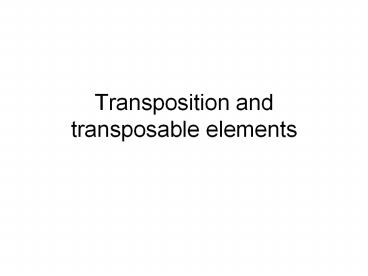Transposition and transposable elements PowerPoint PPT Presentation
Title: Transposition and transposable elements
1
Transposition and transposable elements
2
Transposable elements
- mobile genetic elements
- comprise 45 of human chromosomal DNA middle
repetitive DNA - contribute to spontaneous mutation, genetic
rearrangements, horizontal transfer of genetic
material - aid speciation and genomic change (in bacteria
transposons are often associated with antibiotic
resistance genes) - cells must depress transposition to insure
genetic stability
3
Types of transposable elements
- DNA vs. RNA
- viral vs. nonviral
- replicative mechanism vs. excision mechanism
4
transposon
5
insertion mutation
transposon
6
Discovery of transposons
- Barbara McClintock 1950s Ac Ds system in maize
influencing kernel colorunstable
elementschanging map positionpromote
chromosomal breaks - Rediscovery of bacterial insertion
sequencessource of polar mutationsdiscrete
change in physical length of DNAinverted repeat
ends form lollipops in EM after
denaturation/reannealing
7
Composite bacterial transposons
- repeated ends, usually inverted, sometimes direct
- repeated ends themselves are IS elements and can
independently transpose - ends mobilize all intervening DNA
- often antibiotic resistance genes (examples Tn3
(ampicillin), Tn5 (kanamycin), Tn10
(tetracycline) - often reside on plasmids
8
Basic minimal insertion sequence structure
tnp ORF
ends genetically required, in cis tnp
(transposase) genetically required, trans-acting
Element 1 Element 2 Transposition?
wt wt 1 and 2
ends- ends- neither
trp- tnp- neither
ends- wt only 2
tnp- wt 1 and 2
tnp- ends- only 1
9
Structure of Tn3
4957 bp
3 trans-acting genes
2 cis-acting sites
10
tnpR and res mutations cause accumulation of
co-integrate structure
11
2 types of DNA tranposons
- excisive mechanismexamples Tn5, Tn10, P
elements - replicative mechanismexamples Tn3,
bacteriophage Mu
12
Replicative transposons
- orignal cut of transposon is only nick and only
one strand is initially ligated - element replicates through itself
- produces as intermediate a co-integrate
structure - co-integrate is resolved by resolvase (as TnpR of
Tn3) and at specific site (as res of Tn3)
13
Excisive transposons
- cut-and-paste mechanism
- cut themselves out of original site, producing
double strand break - cut target site and ligate to element ends,
thereby inserting at new site - original site break repaired usually with sister
chromosome, restoring transposon at original
site sometimes end healed without transposon,
can also be associated with deletion at excision
site
14
Source of target site duplication TSD
GAC
CTG
15
degenerate transposons
- many naturally occurring transposable elements
have suffered mutation and are no longer active - some of these may have cis-acting end mutations
and cannot be mobilized - others may have intact ends but no transposase
these can be mobilized by a element that is tnp
(autonomous element) - Ac Ds system is an example of latter Ac
(activator) can mobilize Ds (dissociator) - MITEs (minature inverted repeat transposable
elements) are nonautonomous DNA elements - SINEs are retrotransposon version (LINEs)
16
Comparison of transposition reactions
Direct transesterification reactions DDE motif
transposase (integrase)
17
Comparison of tranposase structural organization
18
Mechanism of transposases and retroviral
integrases
19
(No Transcript)
20
Classification of retroelements
- Have obligate RNA intermediate, use reverse
transcriptase (RT, RNA-dependent DNA polymerase) - LTR-retroelements long terminal
repeatsTy1/copia, Ty3/gypsy, retroviruses - Non-LTR-retroelements retroposonsLINES
21
(No Transcript)
22
Characteristics of LTR retroelements
- Long terminal repeats required for replication
cycle - Genes gag, pol, (viruses also have env)
- Pol is polyprotein which gives rise to RT
(reverse transcriptase), IN (integrase) RH (RNase
H), PR (protease) - Forms VLPs virus-like particles
- Integrase is functionally and structurally
similar to transposase of DNA transposons, DDE
motif - Integration gives characteristic TSD
23
LTR element replication
tRNA primer
Multiple template jumps
24
(No Transcript)
25
Characteristics of non-LTR retroelements
- 2 ORFs, orf1, orf2
- Variable TSD
- ORF2 gives rise to EN, endonuclease, (similar to
APE) and RT - Uses target primed reverse transcription TPRT
- Can transduce 3 downstream non-element segments
26
(No Transcript)
27
Target-primed reverse transcription
Explains Insertions are often 5
truncated Transduction of 3 markers
28
(No Transcript)
29
Human L1 (LINE-1) retroelement
- 15 of human DNA
- 520,000 copies, only 3-5,000 are full-length
- Associated with human disease loci
- Transpose specifically in germ line
30
(No Transcript)

